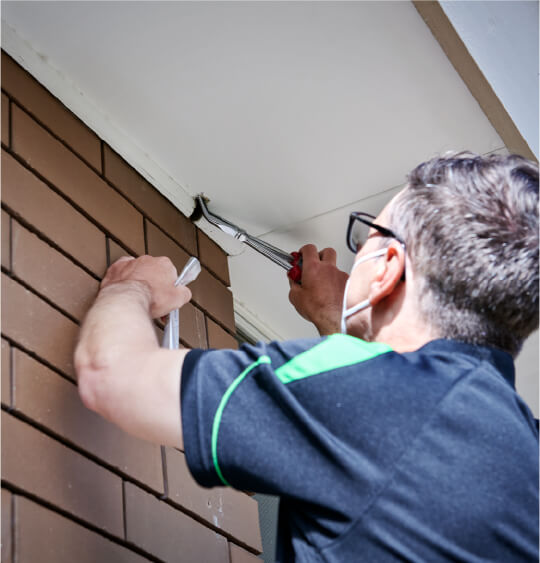Renovation Rescue: The Asbestos Edition
Since the rise of home renovation tv shows, many of us have been inspired to tackle our own DIY home projects. And while working, improving, and maintaining residential properties in Australia isn’t anything new, a new generation of homeowners and DIY renovators are now undertaking these projects for the first time themselves.
Wielding a sledgehammer, power tools or machinery might have some obvious risks and dangers, however, the potential exposure to asbestos is one of the lesser-known risks of home renovations in Australia.
That’s what we are here to help with. We want to help prepare you, by arming you with the information you need to know before you embark on that DIY home renovation project. Keep reading to discover more about asbestos and how you can be prepared so your renovation plans are not derailed.

What is asbestos?
A naturally occurring mineral mined from rock, asbestos is made up of many small silicate fibres and is extremely strong. Asbestos is super versatile due to its high resistance to fire, heat, and chemicals, as well as its insulative properties.
It’s this versatility that saw asbestos being commonly used in the making of building materials – known as asbestos containing materials (ACMs). These ACMs are usually grouped into two types: friable & non-friable.
Non-Friable, also known as bonded asbestos materials, are solid materials where asbestos fibres are mixed with an adhesive product and not able to be crumbled, pulverised, or broken by hand, like cement sheeting commonly used for eaves. Friable asbestos materials are those that are able to be crumbled or broken into dust when light pressure is applied – like loose fill insulation sometimes used in roof cavities and walls. Friable asbestos materials usually contain a higher percentage of asbestos than bonded materials.
When was asbestos used?
Asbestos Containing Materials were commonly used in the Australian building industry post world war II up until 1990s. During the 1980s, asbestos-free alternatives were introduced to the building industry, while the manufacturing of asbestos containing building materials slowed down. It was around this time that the awareness of asbestos related illnesses increased.
While the manufacturing of asbestos containing materials was significantly slowed at this time, it wasn’t until December 31st, 2003, that a complete ban on the sale, use or manufacture of asbestos was in place.
Why exactly was asbestos banned? Why is it bad?
Exposure to asbestos is known to cause several incurable illnesses, including Asbestosis, Lung Cancer and Mesothelioma. These illnesses are caused by breathing in and swallowing microscopic asbestos fibres.
In most instances, asbestos related illnesses have a long latency period, meaning that symptoms related to that illness may not be present for a long time after exposure.
Asbestos fibres are usually not visible to the naked eye when airborne, meaning that many people can be unaware they have been exposed or have potentially ingested these fibres. And there is no safe level of exposure to asbestos.
Therefore, it is extremely important to be aware of when a home may contain asbestos before commencing any work on the property so you are not accidentally exposed to asbestos fibres.
Where might asbestos be in my home?
Up until the 1980s, Australia had one of the highest uses of asbestos per person in the world. Asbestos was predominantly used in the housing and construction industry, and though the manufacturing of asbestos containing building materials slowed in the 1980s, they were still occasionally used in the building of homes around Australia up until the total asbestos ban was in place in 2003.
Homes built in Australia from the 1950s up until the 1990s have a high likelihood of containing asbestos materials. This likelihood decreases from 1990 to 2003, and then homes built from January 1st, 2004, should not have any asbestos materials present, as their usage was banned from this point onwards.
The ways in which asbestos materials were used in homes varies significantly due to the versatile nature of asbestos. Some of the types of asbestos containing materials used in the housing and construction industry include:
1. Fibre Cement Sheeting
2. Loose Fill Insulation
3. Low Density Fibre Boards
4. Vinyl Floor Tiles and Covering
5. Corrugated Cement Sheeting
6. Adhesives
7. Compressed High Density Floor Sheets
8. Cement Moulded Products
These materials were used internally, externally, and in the structure of the home. Because of asbestos’s ability to withstand heat, erosion, decay and water damage, many bathrooms, laundrys and kitchens had asbestos materials used in their construction. Though, asbestos can be present in any area of the home.
You can learn more about the types of asbestos building materials and where they can be found in Australian Homes here.
How do I know if my home has asbestos?
It’s not easy to identify asbestos in the home just by sight, at least not by an untrained individual. Many of the building materials that contain asbestos look similar to asbestos-free alternatives. However, if you are planning to renovate a home, there are some things you can do to help you identify your possible risk to asbestos exposure.
It’s a good idea to know when the home you’re planning to work on was constructed. If the home was built after 2003, you should be in the clear as the use of asbestos was banned from this point. However, if the home was built prior to this time, there is a chance that asbestos materials will be present in your home, and this chance is very high if the home was built prior to 1990.
The other way you can be sure as to whether your home contains any ACMs is by engaging with an asbestos inspection professional, like Greenlight. We offer residential asbestos inspections that are conducted by tertiary qualified asbestos assessors. As part of this service, we take samples from areas of your home and assess them in our NATA accredited lab, with results available within a 48-hour period. The advantage of using a service like this is not only can you confidently have asbestos materials in your home identified, but you will also have it done by an independent service whose interest is in helping to identify asbestos risks and manage them for your safety.
What should I do if there is asbestos in my home?
If asbestos is present in a home, it’s not always a risk to you and your family’s health. If in good condition, asbestos materials can last for very long periods, and pose no health risks. However, once asbestos is identified in a home, it is important to monitor and manage the asbestos in your home.
As part of a Greenlight residential asbestos inspection, you will receive a clear and concise report that clearly outlines if a material contains asbestos. If we identify materials as containing asbestos, we will provide a risk assessment and recommendation which will be based on your planned usage of the site.
This report can also be used by all tradespeople who may conduct work on your site and will ensure that accidental disturbance of any asbestos is avoided.
Removing asbestos from your home
If asbestos materials are found in your home, how do you get rid of them? Depending on the extent of the planned works on your home, and the condition of the materials, you may not need to remove them. However, it is important to note that any disturbance of the asbestos containing materials that causes asbestos fibres to be released can expose you to the dangers of asbestos.
If removal is the right option for you, depending on your location and the amount of asbestos, you may be able to do it yourself, or you can seek the help of a professional removalist.
DIY Asbestos Removal
In most Australian states and territories (excluding the ACT), a non-licensed individual can remove asbestos, as long as it is non-friable (bonded) asbestos, and the amount is no larger than 10 square metres. This asbestos, once removed, then needs to be disposed of correctly, according to the guidelines of your state. If the amount of bonded asbestos materials is greater than this, a Class B asbestos removal licence is required.
No amount of friable asbestos materials can be removed by a non-licensed individual.
But just because you can remove it yourself, it does not mean that you should. As we mentioned earlier, the health risks of exposure to asbestos are significant, and given the restrictions on the amount that you can remove yourself, at Greenlight we recommend working with a professional removalist. As much as possible, avoid DIY asbestos removal.
Professional Asbestos Removal
Professional licensed asbestos removals will be able to help you with managing the removal of asbestos materials from your home and save you from the hassle and risks of trying to do it yourself.
When looking for an asbestos removalist, it is important to keep in mind that there are two types of asbestos removal licenses – Class A & Class B.
Class B Licence:
This allows the asbestos removalist to remove non-friable asbestos, and any asbestos contaminated dust that has been derived from the removable of the non-friable asbestos. However, they are unable to remove friable asbestos.
Class A License Holders:
A Class A licence holder can perform the same removal of asbestos as a class B license holder, however, in addition to being able to remove non-friable asbestos they can also remove friable asbestos as well.
The licensed removalist should be registered with WorkSafe and should notify WorkSafe in advance before any asbestos removal work is carried out.
If you are looking for an asbestos removalist, do not be afraid to ask to see their accreditation and licenses. Afterall, it is your home and safety.
Alternatively, WorkSafe has a directory of licenced asbestos removalist specialists available for you to browse.
Get your renovation started with Greenlight’s help
Whether you’re in the planning stages of your home renovation, or you think you may have stumbled across asbestos in your home, it’s best to make sure you know exactly what you’re faced with, and that’s where Greenlight can help you.
We can conduct an asbestos inspection of your home and help you identify whether any asbestos is present. As part of our residential asbestos inspection, we will provide a report that includes photos alongside each entry that will not only identify where asbestos is present, the report will also advise the condition of the asbestos, include a formal risk assessment and specific recommendations for the asbestos containing item.
In addition to showing you where the asbestos is, a greenlight report will also outline the inspected areas that do not contain any asbestos. This way you are aware of what does and does not contain asbestos and will remove any guesswork from the equation.
You can also be confident in knowing that each of our occupational hygiene specialists are tertiary qualified and highly experienced, able to work to the individual needs of you and your property.
Here at Greenlight, we’re unbiased and independent occupational hygiene specialists, with the aim to help reduce your risk to asbestos and other hazardous materials in your home and workplace.
We take great pride in our work and have designed our service catalogue to allow you to understand and make informed decisions when it comes to the safety of yourself, your family and your home.
If you’re thinking about taking on a home renovation, give us a call on 03 9048 4411.

Melbourne Based OHS Consultancy | Hazard Identification & Management
Book Your Onsite Inspection NowRecent Posts

A Homeowner’s Guide to Asbestos in Houses
View Post »
Greenlight on 3AW
View Post »

